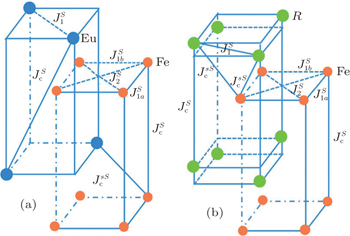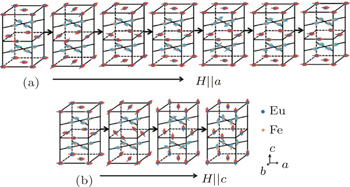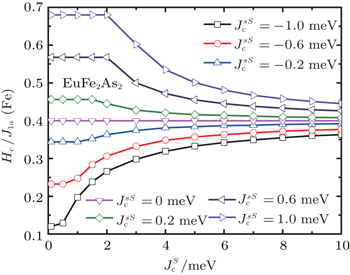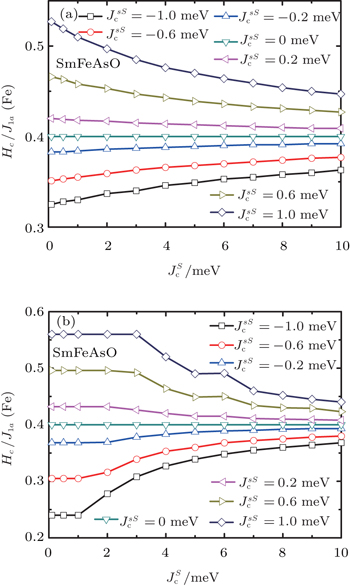† Corresponding author. E-mail:
‡ Corresponding author. E-mail:
Project supported by the National Natural Science Foundation of China (Grant Nos. 11104274, 11274310, and 11474287) and the Fundamental Research Funds for the Central Universities, China (Grant No. 27R1310020A).
The magnetic properties of iron pnictide superconductors with magnetic rare-earth ions under strong magnetic field are investigated based on the cluster self-consistent field method. Starting from an effective Heisenberg model, we present the evolution of magnetic structures on magnetic field in R/FeAsO (R = Ce, Pr, Nd, Sm, Gd, and Tb) and R/Fe2As2 (R = Eu) compounds. It is found that spin-flop transition occurs in both rare-earth and iron layers under magnetic field, in good agreement with the experimental results. The interplay between rare-earth and iron spins plays a key role in the magnetic-field-driven magnetic phase transition, which suggests that the rare-earth layers can modulate the magnetic behaviors of iron layers. In addition, the factors that affect the critical magnetic field for spin-flop transition are also discussed.
Since the iron-based superconductors were discovered,[1] the families of iron pnictides and chalcogenides display very rich phase diagrams, including antiferromagnetism or spin-density wave,[2,3] superconductivity,[1] structural/magnetic phase transitions,[3] orbital ordering,[4–7] and nematic ordered phase,[8] etc. The proximity of magnetism and superconductivity suggests the spin degree of freedom plays a key role in understanding the basic low-energy physics of the iron-based superconductors. And spin fluctuations have been proposed as the unconventional superconducting mechanism of iron-based superconductors.[9] Thus, to understand the magnetic properties is a primary task in uncovering the microscopic mechanism of the iron-based superconductivity.
Through many magnetic measurements, mainly with the help of the neutron scattering techniques, various antiferromagnetic (AFM) structures in different ironpnictide compounds have been determined; the 1111 (RFeAsO with R = rare-earth ions), the 111 (AFeAs with A = alkali metal ions, e.g., Na), and the 122 phases (AFe2As2 with A = alkaline earth metal ions, e.g., Ba, and RFe2As2 with R = rare-earth ions, e.g., Eu), possess striped AFM (SAFM) order,[3,10–12] while FeTe is bi-collinear AFM (BAFM),[13] etc. Among these compounds, the parent compounds with magnetic rare-earth ions, such as RFeAsO (R = Ce, Pr, Nd, Sm, Gd, and Tb) and EuFe2As2, have demonstrated particular interesting. SmFeAsO1−xFx shows the maximum Tc with about 55 K,[14] in other iron-pnictides with magnetic rare-earth ions, the Tc is about 41 K for Ce,[15] 52 K for Pr,[16] and 51 K for Nd.[17] However, in EuFe2As2, the Tc is only about 29.5 K.[18] Since the basic FeAs units are very similar in these systems, the superconducting transition temperatures Tc are very different, indicating a possibly distinct magnetic interaction between rare-earth and Fe layers in different compounds, and these distinct magnetic coupling is crucial in promoting the superconducting transition temperature.
Especially, these magnetic rare-earth ions exhibit different magnetic interactions, resulting in a more complicated magnetic behaviors. For example, in 1111 system, the rare earth ions of RFeAsO are AFM, and undergo an AFM-paramagnetic phase transition at TN.[19] While in 122 system, such as in EuFe2As2, Eu2+ ions display a ferromagnetic (FM) ordering,[12] etc. A series of experiments had been performed to investigate the role of the magnetic rare-earth ions on the Fe-3d magnetism and superconductivity. Meanwhile, the influence of magnetic field on these complicated magnetic ordering are also investigated using static and pulsed field techniques. It is found when a magnetic field is applied in EuFe2As2, a spin-flop transition occurs in rear-earth Eu layer observed experimentally at a very low magnetic field.[20–22] In addition, in SmFeAsO, at a high pulsed magnetic field, a spin-flop like transition is also observed.[23]
These experiments have demonstrated that in ironpnictide superconductors the magnetic structures under magnetic field display a complex phenomenon. Thus, a question naturally arises: what role do the magnetic rare-earth ions and magnetic field play on the magnetism and superconductivity of the FeAs layers in these rare-earth compounds? To address this question, a detailed theoretical investigation is expected. In this paper, we present the effect of magnetic rare-earth ions and magnetic field on the magnetism of iron-pnictide compounds and investigate the interplay of magnetic rear-earth and Fe ions. This paper is organized as follows: a model Hamiltonian and the cluster self-consistent field (Cluster-SCF) method are described in Section 2; then the results and discussion are presented in Section 3; the last section is devoted to the remarks and conclusions.
It has been shown that the effective Heisenberg models provide a reasonable description for the magnetic structure and spin wave behaviors in the iron-based superconductors.[24] The J1–J2 frustrated Heisenberg model was firstly proposed to describe the magnetic properties of the iron-based superconductors. While, the inelastic neutron scattering experiments found a large in-plane anisotropy in the magnetic interactions,[25] suggesting the magnetic exchange constants J1a > J1b with a denoting the AFM direction and b the FM direction. Thus an effective J1a–J1b–J2 model could well describe the striped AFM (SAFM) order in iron-based compounds.[26] Here we start from the J1a–J1b–J2 Heisenberg model.
An effective J1a–J1b–J2 Heisenberg model for iron-based compounds is described as,





We consider the magnetic couplings in the rare-earth layer as





It is known that the external magnetic field is an effective tool to modulate the spin degree of freedom. In this paper we mainly consider two kinds of magnetic field, one (B∥) is applied along the direction of a or b axis of the magnetic unit cell, and another (B⊥) is perpendicular to it (i.e., along the direction of c axis). In general, the external magnetic field is described as

In order to treat with the spin correlations and fluctuations including short-range ones accurately, we adopt the cluster self-consistent field (Cluster-SCF) method developed by us to solve this anisotropic Heisenberg model. The main idea of this method as follows: we divide the lattice into a central cluster plus surrounding spins, treat the magnetic interactions of the spins inside the cluster exactly, and the couplings of surrounding spins outside the cluster is treated as self-consistent “molecular” fields. The details could be found in Refs. [27]– [29]. Here we extend our method to deal with the Heisenberg model including the NNN interaction, such as J1–J2 and J1a–J1b–J2 models, etc. As an example to verify our approach, we calculated the phase diagram of J1–J2 Heisenberg model with spin s = 1/2 on a square lattice, and the result is shown in Fig.
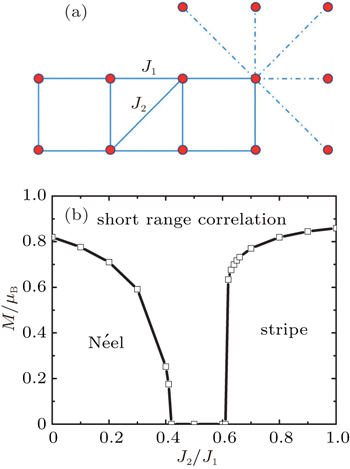 | Fig. 1. (a) Sketch of the square-lattice cluster adopted in our Cluster-SCF approach, and (b) phase diagram of J1–J2 spin-1/2 Heisenberg model obtained by our Cluster-SCF method. |
To solve this Heisenberg model, the magnetic exchange parameters should be given firstly. In order to compare the different rare-earth layers, we use the same parameters for Fe layers in both RFe2As2 and RFeAsO systems. Here we adopt the parameters for Fe layers with 











Utilizing the Cluster-SCF method, we study the influence of magnetic field and the coupling between Fe and rare-earth spins on the magnetic ground states and magnetic phase transition both in RFe2As2 (R = Eu) and in RFeAsO (R = Ce, Pr, Nd, Sm, Gd, and Tb) systems. In the following, we address the detailed results for these two systems for comparison.
We find that in the stable magnetic ground state of RFe2As2 with R = Eu, the Fe spins in FeAs layer are SAFM with interlayer AFM; meanwhile, the Eu2+ spins in the rare-earth layers are ferromagnetic (FM) with the interlayer AFM. Notice that the spin directions of both Eu2+ and Fe2+ ions align in the a–b plane. According to the analysis of the symmetry of the magnetic structure, the influence of rare-earth ions on Fe ions is canceled in the absence of magnetic field within the present mean field approximation. Once the magnetic field is applied, the magnetic rare-earth ions would contribute an effective molecular field on Fe spins. Our results show that when a magnetic field (H ∥ a or H ∥ c) is applied, the system undergoes a series of complicated magnetic phase transitions. As shown in Fig. 

However, the detail of 


The atom-resolved magnetization contributed from Eu2+ and Fe2+ ions are plotted for H ∥ a and H ∥ c in Fig. 


 | Fig. 4. Dependence of magnetization components, Ma and Mb, of Eu2+ ions and of Fe2+ ions on magnetic field (a) and (c) H ∥ a and (b) and (d) H ∥ c in EuFe2As2. |
To further uncover the influence of magnetic field on the magnetic structures in EuFe2As2, we display the evolution of magnetic structure on the magnetic field H in Fig.
In simple systems, it is known that the critical magnetic field of the spin-flop transition is proportional to the single-ion anisotropy energy. In the present complicated magnetic systems, however, due to the interlayer coupling between Eu2+ and Fe2+ ions, the variation of the critical magnetic field is very complex, as seen in Fig. 




Actually, the magnetism of 4f electrons in RFeAsO (R = Ce, Pr, Nd, Sm Gd, and Tb) is very different from that in RFe2As2. In order to investigate the magnetic interplay between 4f and 3d electrons, we also calculate the magnetic properties of RFeAsO (R = Sm). For RFeAsO (R = Sm), the calculated magnetic ground state of the rare-earth layer is Néel-AFM (NAFM) with interlayer AFM, and that of Fe layer is SAFM with an AFM interlayer Fe spins. In the present case, the spin directions of Sm2+ and Fe2+ ions align along the c axis and in the a–b plane, respectively. As a consequence, when a magnetic field (H ∥ a or H ∥ c) is applied, the system undergoes a complex magnetic phase transition and is different from EuFe2As2. As shown in Fig.
The atom-resolved magnetizations of Sm2+ and Fe2+ ions in SmFeAsO are also plotted in Fig.
 | Fig. 8. Dependence of the sublattice magnetization components (Ma and Mb) of Sm2+ ion on magnetic field (a) H ∥ a and (b) H ∥ c in SmFeAsO. |
The evolution of magnetic structure in SmFeAsO on applied magnetic field H is displayed in Fig.
 | Fig. 9. Evolution of magnetic structure on applied magnetic field H ∥ a (a) and H ∥ c (b) in SmFeAsO. |
In SmFeAsO, the dependence of critical magnetic field of the Fe-spin flop (Hc(Fe)) on the interlayer coupling 



In the series of RFeAsO, the experiments found that the Néel transition temperatures for R = Ce, Pr, Sm, Gd, and Tb layers as well as Fe layers, are 


In summary, we investigate the magnetic phase transition behavior in both 1111 and 122 systems with 4f-electrons. Our results demonstrate that the interplay of 3d and 4f spins plays a key role in the magnetic field dependence of these iron-based superconductors with magnetic rare-earth ions. The magnetic rare-earth layers, like magnetic intercalated layers, can tune the spin flop transition of the square Fe lattice in iron-based compounds. We expect that further experiments of strong static or pulsed magnetic field could verify these field-induced magnetic phase transitions.
| 1 | |
| 2 | |
| 3 | |
| 4 | |
| 5 | |
| 6 | |
| 7 | |
| 8 | |
| 9 | |
| 10 | |
| 11 | |
| 12 | |
| 13 | |
| 14 | |
| 15 | |
| 16 | |
| 17 | |
| 18 | |
| 19 | |
| 20 | |
| 21 | |
| 22 | |
| 23 | |
| 24 | |
| 25 | |
| 26 | |
| 27 | |
| 28 | |
| 29 | |
| 30 | |
| 31 | |
| 32 | |
| 33 | |
| 34 | |
| 35 | |
| 36 | |
| 37 | |
| 38 |



